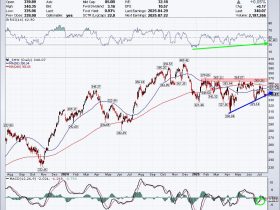A few weeks back, two gold mining ETFs made it to the top 10 of the StockCharts Technical Rank (SCTR) Report, and they’re still holding strong. Given the low trading volume in these ETFs, a more tradable alternative is the VanEck Vectors Gold Miners ETF (GDX), which still has a high SCTR (pronounced “scooter”) score. As of this writing, it’s at 98.
Looking back, how did GDX perform? It helps to revisit the article, which laid out the conditions and criteria for the uptrend—namely, key levels of support and resistance, price points which would determine either a trend continuation or reversal, and the seasonality context which can inform the more fundamental (and geopolitical) forces affecting the gold trade.
Referring to the original chart while tracking the events in the days after the article dropped, here’s what happened.
CHART 1. DAILY CHART OF GDX. Everything to the right of the blue vertical line shows what occurred after the article dropped.Chart source: StockCharts.com. For educational purposes.
As anticipated, GDX bounced at the Ichimoku Cloud line and broke above the swing point at $40 (see the ZigZag line) while remaining well below the then-previous swing low. It demonstrated the classic uptrend principle of higher highs and lower lows.
Meanwhile, buying pressure started to drop, based on the Chaikin Money Flow (CMF) readings, indicating weakness in momentum and a potential pullback.
A Short-Term Trade Within a Longer-Term Investment
Nobody knows how gold or gold miners will fare in the coming months. Analyst predictions are all over the map—and given the economic, political, and global context, it’s really no surprise.
However, you can prepare for multiple scenarios. One approach traders use is to capitalize on short-term trading opportunities as they arise, taking profits along the way.
With that in mind, the August low-to-high rally and September pullback presented an ideal opportunity to trade a “measured move.”
What is a Measured Move?
Simply put, a measured move is a three-part trading pattern comprised of the following:
An initial move in one direction (like a rally)A pullbackA continuation in the original direction that mirrors the height of the first move
The goal is to forecast the height of the final move based on the initial move. Whether the outcome of a measured move trade works in your favor or not, it provides you with a clear target and two clear exits in the form of a stop loss and profit target.
Take a look at GDX’s daily chart below.
CHART 2. DAILY CHART OF GDX. You can use the percent change tool to measure and then project a given price move.Chart source: StockChartsACP. For educational purposes.
GDX’s price move from its August 5 low to its August 20 high was approximately 18.60%. I used the Percent Change tool (available in the Annotation tool in SharpCharts and StockChartsACP) to measure this change (orange percent change measurement).
According to the “measured move” principle, the next leg up starting from the bounce on September 6 would be roughly equal to this first move. So, the second percent change ruler starts at the low of September 6 and extends its height to approximate the first measurement (blue percent change measurement).
The above chart shows that the price is about 90% of the way through the measured move. The blue rectangle on the chart shows the remaining space needed to complete the full 100% move.
How to Trade GDX
The September 6 low was a good “long” entry point for holding GDX long-term. But if you wanted to play it safe, given the longer-term uncertainty in the market, you could have used the “measured move” principles to pull off a short-term trade. Another option would be to lighten your position by unloading a portion of it by setting a profit target using the measured move principles.
Closing Bell
Short-term trading is a distinct approach that not all traders will adopt. But it also presents opportunities to take profits along the way as you chase longer-term profit goals. There are multiple swing trading setups you can use to pursue a trade within a (longer-term) trade, and using measured move principles—for trend continuation and various other patterns—is one clear way to approach such a pursuit. The GDX scenario above illustrates a clear way in which you could have used this strategy.
Disclaimer: This blog is for educational purposes only and should not be construed as financial advice. The ideas and strategies should never be used without first assessing your own personal and financial situation, or without consulting a financial professional.








